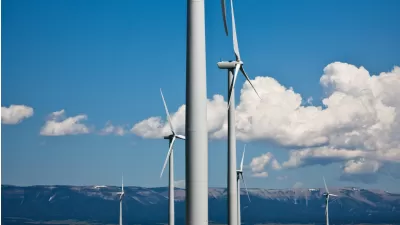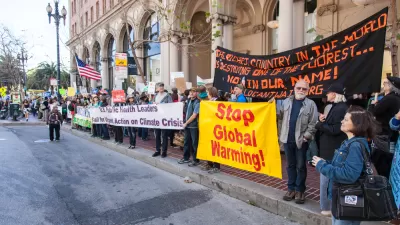It has been a good year for environmentalists, but it hasn't come easily, as seen in the much-celebrated but delayed passage of SB 32 that continues the landmark emissions reductions first set in 2006. Joe Mathews explains the transitions underway.

The passage of two key environmental bills 'joined at the hip,' SB 32 and AB 197, is the basis of an insightful column — not on the bills but their authors, Sen. Fran Pavley (D-Agoura Hills, Los Angeles County) and first-term Assemblyman Eduardo Garcia (D-Coachella, Riverside County), respectively, by Joe Mathews, who writes the Connecting California column for Zócalo Public Square.
The termed-out Pavley authored landmark environmental bills AB 32, The Global Warming Solutions Act of 2006 and AB 1493, Vehicular emissions: greenhouse gases, signed into law by Gov. Gray Davis in 2002, more often simply called the Pavley (or Clean Car) Standards.
According to Assembly Speaker Anthony Rendon (D-Paramount, Los Angeles County), the Pavley-Garcia partnership came "together at the Paris climate talks in December, when Garcia was added to a California delegation that included Gov. Jerry Brown, legislative leaders, and Pavley."
Mathews doesn't go into the relationship of the two bills that passed the legislature last week (more on that below) other than stating, "SB 32 extends the greenhouse gas reduction targets to 2030, and AB 197 creates oversight of state climate programs to make sure their benefits help the economies and public health of poorer and more polluted communities." Instead, his piece is about the changes in environmental leadership underway illustrated by the two authors.
The change goes far beyond generational. Most evident is a policy "shift in focus, from greenhouse gases to the impact of climate change—and measures to combat it—on people and specific places," and a geographic shift as growth has moved inland, away from the high housing costs of coastal cities.
Along with the generational change of leadership comes one with more diversity, represented by Garcia and Senate President pro Tem Kevin de León, reflecting the fast-growing Latino population, 38 percent of the state's population in 2010.
De León is author of another landmark bill, SB 350 passed last year that increases the renewable portfolio standard to generating 50 percent of electricity from renewable sources by 2030 and doubling energy efficiency standards in buildings by the same year.
But reductions are no longer sufficient, as illustrated by another de Léon key bill, SB 535 in 2012 that requires that 25 percent of cap-and-trade auction proceeds be direct to projects that provide benefits to disadvantaged communities
There are more constituents for climate change legislation, and thus higher expectations. And that has forced climate legislation to do more than mandate reductions in greenhouse gases; representatives of the state’s poorer, inland places are demanding that regulations and programs improve public health and create job opportunities in their communities.
The rather uneasy relationship between SB 32 and AB 197 is the topic of a San Diego Union-Tribune editorial which asks, "Is this it for California’s big climate change laws?" It explains why Garcia's bill was needed for Pavley's to pass.
His bill is meant to address the concerns of 20 or so moderate Assembly Democrats, some from poorer communities, who have begun to question the idea that green regulations benefit their home district.
But any Californian who values the state’s reputation as an environmental pioneer needs to worry about the fault lines among state Democrats exposed by the debate over AB 197 and by the failure in 2015 of Brown’s and Senate President Kevin de León’s push for a new law dramatically reducing gasoline use in the state.
Liam Dillon reported for the Los Angeles Times on the growing divisions in the Democratic party, particularly in the Assembly where many Senate climate bill die due to dissent from a number of black and Latino leaders. He includes the debate about how much of the unallocated $1.4 billion of Greenhouse Gas Reduction Funds should be directed to "disadvantaged communities — defined as regions with high levels of pollution and high poverty." A compromise was reached on Aug. 31, the last day of the 2016 legislative session.
Capital Public Radio has a roundup of action on the final day.
FULL STORY: The Next Big Shift in California’s Climate Change Movement

Alabama: Trump Terminates Settlements for Black Communities Harmed By Raw Sewage
Trump deemed the landmark civil rights agreement “illegal DEI and environmental justice policy.”

Study: Maui’s Plan to Convert Vacation Rentals to Long-Term Housing Could Cause Nearly $1 Billion Economic Loss
The plan would reduce visitor accommodation by 25% resulting in 1,900 jobs lost.

Planetizen Federal Action Tracker
A weekly monitor of how Trump’s orders and actions are impacting planners and planning in America.

Wind Energy on the Rise Despite Federal Policy Reversal
The Trump administration is revoking federal support for renewable energy, but demand for new projects continues unabated.

Passengers Flock to Caltrain After Electrification
The new electric trains are running faster and more reliably, leading to strong ridership growth on the Bay Area rail system.

Texas Churches Rally Behind ‘Yes in God’s Back Yard’ Legislation
Religious leaders want the state to reduce zoning regulations to streamline leasing church-owned land to housing developers.
Urban Design for Planners 1: Software Tools
This six-course series explores essential urban design concepts using open source software and equips planners with the tools they need to participate fully in the urban design process.
Planning for Universal Design
Learn the tools for implementing Universal Design in planning regulations.
Caltrans
Smith Gee Studio
Institute for Housing and Urban Development Studies (IHS)
City of Grandview
Harvard GSD Executive Education
Toledo-Lucas County Plan Commissions
Salt Lake City
NYU Wagner Graduate School of Public Service





























